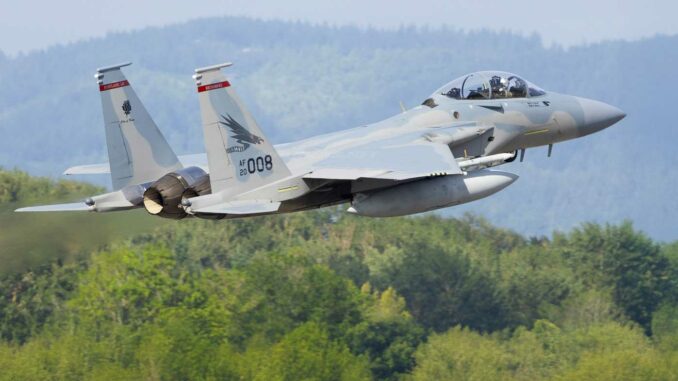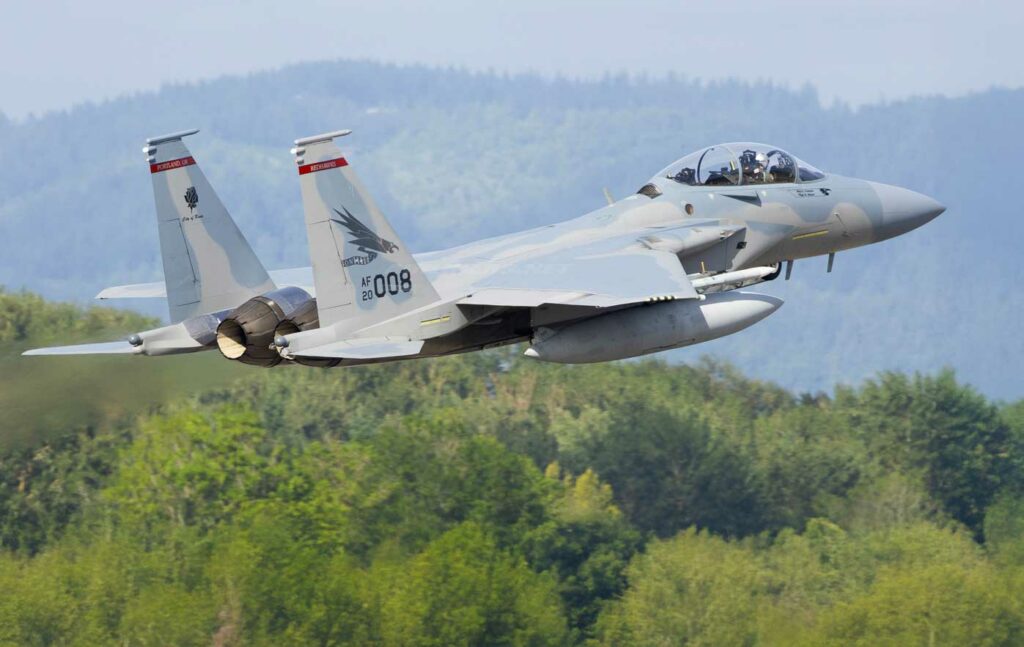
The Pentagon’s 2026 budget includes 129 F-15EX fighter jets, a strategic shift for the USAF in light of reduced F-35 purchases.
The US Department of Defense announced in its 2026 budget proposal that it would expand the F-15EX program to 129 aircraft, up from 98 initially. This ramp-up coincides with the decision to equip the Michigan Air National Guard with 21 units. Other squadrons located in Portland, Fresno, New Orleans, and Kadena (Japan) will also receive this model. The estimated cost of the operation is $2.8 billion. The F-15EX aircraft, an evolution of the F-15 designed in the 1970s, is intended to meet a need for rapid fleet renewal while limiting the risks associated with delays in the F-35 program. The decision to maintain a production line in St. Louis strengthens Boeing’s position, which also benefits from the NGAD (Next Generation Air Dominance) contract. This budgetary focus reflects a political commitment to ensuring credible strike capability that is rapidly available, with technologically proven aircraft.
A budget decision that increases the program by 31 aircraft
The 2026 budget presented by the US Department of Defense allocates $3 billion (approximately €2.8 billion) for the purchase of new F-15EX aircraft. This funding will increase the planned fleet from 98 to 129 aircraft, a net increase of 31 units. This decision was confirmed by a senior USAF official at a press conference.
The F-15EX program, also known as Eagle II, is based on the proven architecture of the F-15, while incorporating modern systems: AN/APG-82 AESA radar, EPAWSS electronic warfare, digital cockpit, advanced data link, and the ability to carry up to 13.6 tons of munitions. This model will enable the rapid replacement of squadrons still operating aging F-15C/D aircraft, some of which have exceeded 8,000 flight hours.
The funding is also linked to the reassignment of units: the Michigan Air National Guard, which is losing its A-10s, will receive 21 F-15EXs. This figure exceeds the planned standard of 18 aircraft per squadron, suggesting an adjustment of the force structure towards larger units.
The 129 aircraft could be broken down as follows:
- 5 squadrons of 18 aircraft: 90 units
- 1 squadron (Michigan): 21 units
- Testing, evaluation, training: 8 to 10 units
- Operational reserve or possible additional squadron: 10 to 12 units
This format would make it possible to rebuild air superiority in support of national and international missions without relying exclusively on the F-35, which is more expensive and still in the technical maturation phase for some of its functions (Block 4 in particular).
A response to the operational constraints of the USAF
The strengthening of the F-15EX program is based on operational logic. The US Air Force still has many F-15C/Ds, which are becoming increasingly expensive to maintain. Modernizing these airframes would be economically irrational: according to internal Air Force estimates, the unit cost of an F-15EX is less than $90 million (≈€84 million), compared to approximately €150 million for an F-35A once equipped and supported in its long-range combat missions.
The F-15EX offers long-range air-to-air strike capabilities, with the integration of the AIM-260 JATM missile, a competitor to the European Meteor. It can also carry heavy loads such as the GBU-57 (a 13-ton bunker buster) thanks to its robust structure, giving it an advantage for conventional penetration missions without stealth.
This strategy aims to fill the immediate availability gaps in the stealth fleet. The F-35 is a capable aircraft, but its availability rate remains below 60% in some squadrons due to logistical complexity and delays in updating Block 4 software.
In other words, the F-15EX is an immediately operational aircraft, suitable for high-intensity conflicts, while being less dependent on a complex digital support chain. Its twin engines (F110-GE-129) also ensure superior reliability in extended environments.

Industrial consolidation for Boeing
The expansion of the F-15EX program strengthens Boeing Defense‘s position, particularly in light of the temporary reduction in F-35 orders from Lockheed Martin. In the 2026 budget, only 47 F-35s will be acquired, compared to 74 originally planned, in order to reallocate funds to software modernization and fleet maintenance.
For Boeing, the F-15EX becomes the only fighter jet still produced in St. Louis, on an assembly line optimized to produce up to two to three aircraft per month. At full capacity, this pace would allow for the delivery of 129 aircraft in approximately four to five years, without interruption.
This sustained production has several concrete effects:
- Maintaining more than 5,000 direct jobs and subcontractors in Missouri
- Guaranteeing an industrial continuum while awaiting the NGAD (Next Generation Air Dominance) program
- Resilience to the risks of dependence on a single 5th generation aircraft
Boeing’s victory in the F-47 NGAD contract adds a second lever for growth, but this program is not expected to enter initial service before 2030. In the meantime, the F-15EX will support exports, particularly to countries such as Indonesia and Israel, which are interested in this versatile, non-stealth model.
Strategic consequences and political implications
The extension of the F-15EX program can also be interpreted in light of political and strategic considerations. The Trump administration, in its second term, is seeking to reorient military planning toward formats that are immediately available, robust, and less dependent on pure stealth technology.
The choice of the F-15EX indicates a preference for a doctrine of massive firepower, capable of saturating contested airspace, particularly in the Indo-Pacific, in the face of China’s rising power.
The bases at Kadena in Japan, Fresno, and Portland have been identified as entry points for the F-15EX into areas of tension. This orientation suggests that the USAF is betting on a medium-range projection capability, with a high volume of onboard munitions, in an environment where stealth could be compromised by passive radars and multi-sensor networks.
Finally, domestically, this decision also serves to consolidate Trump’s political base in industrial states such as Missouri, Oregon, and Michigan. Maintaining production lines, reassigning squadrons, and giving the United States visibility in this program are all part of a clear industrial policy.
War Wings Daily is an independant magazine.